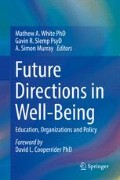Abstract
The issue of adolescents and poor sleep has been vexing experts in public health for over a century. This is not a new problem for well-being, but despite longstanding recognition, the pattern of the preceding century has been a steadily decreasing amount of childhood sleep (Matricciani LA, Olds TS, Blunden S, Rigney G, Williams MT, Pediatrics 129(3):548–556, 2012). Paradoxically, the extent and severity of this problem is perhaps easiest to ignore because of how widespread it is – sleep deprived teenagers are regarded as normal. Some 33% of young Australians report difficulties falling asleep, and on average Australian teenagers are thought to get 8 hours of sleep per night, an hour short of the recommended amount of adolescent sleep (Short MA, Gradisar M, Lack LC, Wright HR, Dohnt H, J Adolesc 36(1):103–110, 2013). It is worth reflecting on the causes of this lost hour and the potential consequences of widespread chronic sleep deprivation. This is not an individual problem, but a public health issue that schools are well placed to take part in addressing.
Access this chapter
Tax calculation will be finalised at checkout
Purchases are for personal use only
References
Bartel, K. A., Gradisar, M., & Williamson, P. (2015). Protective and risk factors for adolescent sleep: A meta-analytic review. Sleep Medicine Reviews, 21, 72–85.
Bonnar, D., Gradisar, M., Moseley, L., Coughlin, A. M., Cain, N., & Short, M. A. (2015). Evaluation of novel school-based interventions for adolescent sleep problems: Does parental involvement and bright light improve outcomes? Sleep Health, 1(1), 66–74.
Carskadon, M. A. (1982). The second decade. In C. Guilleminault (Ed.), Sleeping and waking disorders: indications and techniques (99–125). Menlo Park: Addison–Wesley.
Carrell, S. E., Maghakian, T., & West, J. E. (2011). A’s from Zzzz’s? The causal effect of school start time on the academic achievement of adolescents. American Economic Journal: Economic Policy, 3(3), 62–81.
Dewald, J. F., Meijer, A. M., Oort, F. J., Kerkhof, G. A., & Bögels, S. M. (2010). The influence of sleep quality, sleep duration and sleepiness on school performance in children and adolescents: A meta-analytic review. Sleep Medicine Reviews, 14(3), 179–189.
Groeger, J. A. (2006). Youthfulness, inexperience, and sleep loss: The problems young drivers face and those they pose for us. Injury Prevention, 12(suppl 1), i19–i24.
Heath, M., Sutherland, C., Bartel, K., Gradisar, M., Williamson, P., Lovato, N., & Micic, G. (2014). Does one hour of bright or short-wavelength filtered tablet screen light have a meaningful effect on adolescents’ pre-bedtime alertness, sleep, and daytime functioning? Chronobiology International, 31(4), 496–505.
Hiller, R. M., Lovato, N., Gradisar, M., Oliver, M., & Slater, A. (2014). Trying to fall asleep while catastrophising: What sleep-disordered adolescents think and feel. Sleep Medicine, 15(1), 96–103.
Hysing, M., Haugland, S., Stormark, K. M., Bøe, T., & Sivertsen, B. (2015). Sleep and school attendance in adolescence: Results from a large population-based study. Scandinavian Journal of Public Health, 43(1), 2–9.
Lovato, N., & Gradisar, M. (2014). A meta-analysis and model of the relationship between sleep and depression in adolescents: Recommendations for future research and clinical practice. Sleep Medicine Reviews, 18(6), 521–529.
Matricciani, L. A., Olds, T. S., Blunden, S., Rigney, G., & Williams, M. T. (2012). Never enough sleep: A brief history of sleep recommendations for children. Pediatrics, 129(3), 548–556.
Short, M. A., Gradisar, M., Lack, L. C., Wright, H. R., & Dohnt, H. (2013). The sleep patterns and well-being of Australian adolescents. Journal of Adolescence, 36(1), 103–110.
Sleeplessness. BMJ. (1894, September 29). (1761):719.
Wolfson, A. R., & Carskadon, M. A. (2003). Understanding adolescents’ sleep patterns and school performance: A critical appraisal. Sleep Medicine Reviews, 491–506.
Author information
Authors and Affiliations
Corresponding author
Editor information
Editors and Affiliations
Rights and permissions
Copyright information
© 2017 The Anglican Church of Australia Collegiate School of Saint Peter trading as St Peter's College
About this chapter
Cite this chapter
Oliver, M. (2017). An Eyes Open Approach to Teen Sleep Problems. In: White, M., Slemp, G., Murray, A. (eds) Future Directions in Well-Being. Springer, Cham. https://doi.org/10.1007/978-3-319-56889-8_33
Download citation
DOI: https://doi.org/10.1007/978-3-319-56889-8_33
Published:
Publisher Name: Springer, Cham
Print ISBN: 978-3-319-56888-1
Online ISBN: 978-3-319-56889-8
eBook Packages: Behavioral Science and PsychologyBehavioral Science and Psychology (R0)

